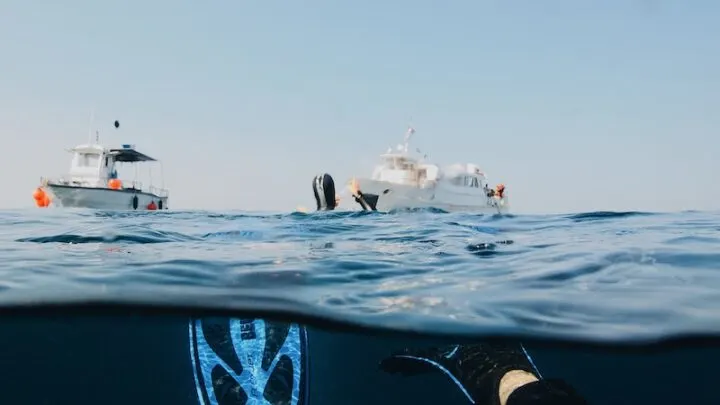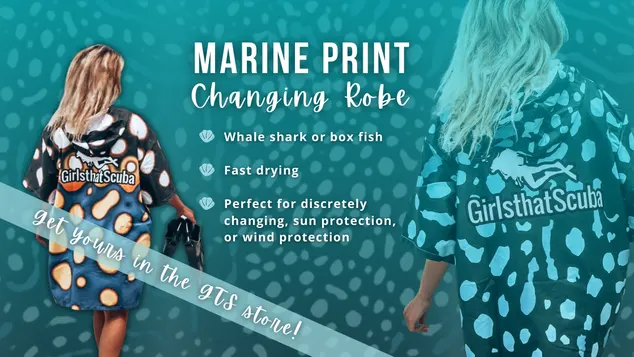Most divers have been there – you’re heading out on the boat dive you’ve been dreaming of for months, but rough seas catch you off guard. Suddenly you fear you might be about to see your breakfast again. Seasickness is more common than you’d think, even for the most seasoned scuba divers.
Whilst it can feel debilitating in the moment, seasickness is easy to overcome with over the counter medication, hydration, and patience. If you’re susceptible to other types of motion sickness, then you could be more likely to get seasick too.
Are there boat diving adventures in your future? Read on to learn what you can do to prevent seasickness, how you can ease seasickness in the moment, and what to do if you experience motion sickness underwater on a dive.
What causes seasickness?
Put simply, seasickness is a form of motion sickness which is specifically experienced at sea.
This motion sickness is caused by a conflict between your brain and your senses. Your inner ear is responsible for your balance. Along with your muscles it can sense that your body is moving around.
If your eyes aren’t perceiving the same movement, such as if you’re inside a boat seeing a relatively still scene, your body sets off a stress response. This can cause nausea, vomiting, and dizziness.
How can I prevent seasickness when diving?
Medication
If you’re predisposed to motion sickness, the simplest way to avoid it when scuba diving is by taking medication beforehand. There are lots of over-the-counter pills available from drug stores and pharmacies. These can be a huge help in avoiding seasickness.
The most important thing to remember if you’re taking them before scuba diving is to look for non-drowsy medication. Pills which cause drowsiness could cause issues with your responses and judgement underwater.
Popular drugs for preventing seasickness include meclizine (branded Bonine), dimenhydrinate (branded Dramamine), and cinnarizine (branded Stugeron), amongst others. Many of these medications work best if taken a number of hours before your boat ride. Some people even recommend taking them the night before to build up the active ingredients in your system. However, you should always follow the medical guidelines in the package and your doctor’s advice.
Medicated Patches
If you suffer consistently with sea sickness or you anticipate spending a lot of time on a boat (such as heading on a liveaboard trip), you can speak to your doctor and ask to be prescribed Scopolamine (Scopoderm) patches.
These patches should be applied behind the ear at least four hours prior to embarking the boat. Scopoderm patches can be worn for up to three days. It may be worth trying them out ahead of a once-in-a-lifetime trip, though. They can cause unpleasant side effects for some people. Again, follow the advice of your doctor to work out whether these are suitable for you.
Non-Medicated Prevention
For those who prefer to avoid taking pills, there are a few steps you can take to minimise the risk of feeling unwell. Avoiding large, heavy meals ahead of boat trips can help. Opt for fresh vegetables and starchy foods over greasy, spicy, or acidic options.
Stay well hydrated but ensure that there’s also some food in your stomach. The feeling of just liquid moving around in the stomach can increase feelings of nausea. Some divers also swear by seasickness wrist bands which work on the theory of pressure points.
How can I ease seasickness in the moment?
If you skipped the seasickness pills but find yourself feeling unexpectedly nauseous, there are a few tried and tested tactics to getting your sea legs back.
Firstly, stay outside of the boat and watch the horizon. The fresh air helps, and seeing the motion of the water helps your brain to realign with what your body and inner ear are experiencing. This should ease the nausea.
It can help to move towards the middle of the boat, as this is where the boat moves the least. Just be mindful to avoid strong smells such as the boat engine exhaust.
Natural Seasickness Remedies
You can also look to natural methods of easing sickness. Ginger in any form is a classic seasickness cure – whether it’s ginger sweets or candies, ginger ale (non-alcoholic on dive days of course), ginger tea, or ginger biscuits.
Some people swear by mint for the same stomach-settling properties. Adding a pack of ginger or mint lozenges to your dive bag may be worthwhile in case sickness catches you off guard.
Green apples are also rumoured to be great for nausea. Their high pectin content supposedly slows down digestion, which in turn settles the stomach.
Will seasickness prevent me from scuba diving?
Seasickness in itself isn’t inherently dangerous, and it’s a lot more common than you’d think – even amongst dive professionals!
If you’re feeling unwell on the boat, it’s likely you’ll feel better just by getting in the water. It’s often calmer under the waves than at the surface. However, although feeling sick and being sick isn’t necessarily harmful, the effects of it can cause some risks when you’re diving.
If you’ve been vomiting you’re likely to become dehydrated, and dehydration increases the risk of decompression sickness. The act of throwing up can also be a lot more physically taxing on the body than you realise.
If you’ve been sick prior to a dive, ensure that you drink plenty of fluids to rehydrate yourself. Sports drinks with electrolytes can be particularly helpful for rehydration. You should also consider taking on an easier dive with more conservative depth and time limits.
What should I do if I feel sick underwater?
Whilst most seasickness subsides once you start your descent, it’s possible to feel nauseous underwater too. This often happens if you’re particularly sensitive to motion sickness. It may be as a result of seasickness on the boat, or could be caused by conditions under the water such as surge.
Surge is different from current. It creates a back-and-forth motion underwater rather than a consistent movement of water in one direction. This can have the same effect of confusing the brain and body as the surface water movement on a boat.
Keep your regulator in
If you do find yourself feeling sick underwater on a dive, the most important thing to remember is to keep your regulator in. Whether you need to cough, sneeze, burp, yawn or vomit underwater, it can be done through the regulator with the mouthpiece in place.
The human body’s first reaction after vomiting is usually a sharp intake of breath. This means it’s extremely important that you keep your regulator in place if you throw up whilst scuba diving. This is a safety precaution. It ensures you don’t try to take a breath and inhale a mouthful of water instead.
Steady yourself
Throwing up isn’t always the most stationary activity, so if you have time to anticipate vomiting try to stabilise yourself first by holding onto something. This could be a buddy or a responsible part of the underwater landscape (i.e. not the reef). You should also physically hold your regulator in your mouth.
The vomit will simply come out of the exhaust valves of your second stage. As they work on a one-way demand valve you will still get a breath of (slightly vomit tainted) air when you next breathe in. It can be helpful to place your tongue gently to the roof of your mouth. This is in case any vomit does sneak back through.
You can also press the purge button whilst you’re throwing up to try to flush the reg out. The one upside to all of this? Underwater residents love the free food, so you’ll get up close and personal with some fishy pals feeding on your leftovers.
When you’ve successfully emptied the contents of your stomach, you will probably want to switch to your alternate regulator. If you anticipate being sick early enough you can swap beforehand, vomit into your alternate, and change back to your primary.
Whilst vomiting isn’t necessarily a dive-ending scenario, keep an eye on how you feel. If you continue to feel unwell or you’re fatigued after throwing up, remember it’s perfectly acceptable to cancel a dive at any time, for any reason.
Clean your regulators thoroughly
Once you’re back topside you’ll need to dedicate a little more time than usual to cleaning your regulators, and if you’re concerned that anything is remaining in the internal parts then you should have them serviced by a professional.
Do your best to clean them first and give them a heads up on why you’re sending them in, though! You should also apply the same courtesy if you’re renting equipment – offer to clean the regs yourself, but make sure the dive operator knows that they might need a bit of extra attention.
What’s your favourite tip for easing seasickness on the dive boat? Join the conversation with thousands of other women divers in our Facebook group!




